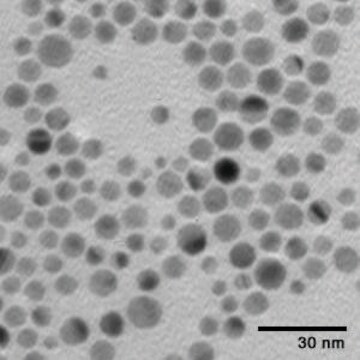Kluczowe dokumenty
741957
Gold nanoparticles
10 nm diameter, OD 1, stabilized suspension in citrate buffer
Synonim(y):
Au NP, Gold Colloid
About This Item
Polecane produkty
Poziom jakości
Formularz
nanoparticles
suspension
zawiera
Proprietary Surfactant as stabilizer
stężenie
~6.0E+12 particles/mL
OD
1
średnica
10 nm
λmaks.
515-523 nm
PDI
<0.2
temp. przechowywania
2-8°C
ciąg SMILES
[Au]
InChI
1S/Au
Klucz InChI
PCHJSUWPFVWCPO-UHFFFAOYSA-N
Szukasz podobnych produktów? Odwiedź Przewodnik dotyczący porównywania produktów
Powiązane kategorie
Opis ogólny
Zastosowanie
- biomedical applications as a drug releasing agents
- cancer radiotherapy due to their excellent surface chemistry and biocompatibility
- electrochemical bio-sensing systems
This material is highly monodisperse (<12% variability in size and shape), and provides significantly improved surface reactivity. Applications include Surface Enhanced Raman Lables, Sensing/Detection, Biological Targeting, Plasmonics and Electronics.
Informacje prawne
Kod klasy składowania
12 - Non Combustible Liquids
Klasa zagrożenia wodnego (WGK)
nwg
Temperatura zapłonu (°F)
Not applicable
Temperatura zapłonu (°C)
Not applicable
Wybierz jedną z najnowszych wersji:
Masz już ten produkt?
Dokumenty związane z niedawno zakupionymi produktami zostały zamieszczone w Bibliotece dokumentów.
Klienci oglądali również te produkty
Produkty
Surface-enhanced Solar Energy Conversion Systems Using Gold and Silver Nanoparticles
Steven J. Oldenburg, Ph.D. provides an overview of lateral flow diagnostic assays and discusses the use of ultra-bright reporter particles based on the unique optical properties of gold nanoshells that significantly increase the sensitivity of lateral flow immunoassays.
Gold (Au) nanoparticles have tunable optical and electronic properties and are used in a number of applications including photovoltaics, sensors, drug delivery & catalysis.
Gold (Au) nanoparticles have tunable optical and electronic properties and are used in a number of applications including photovoltaics, sensors, drug delivery & catalysis.
Global Trade Item Number
| SKU | GTIN |
|---|---|
| 741957-100ML | 4061832885957 |
| 741957-25ML | 4061832885971 |
Nasz zespół naukowców ma doświadczenie we wszystkich obszarach badań, w tym w naukach przyrodniczych, materiałoznawstwie, syntezie chemicznej, chromatografii, analityce i wielu innych dziedzinach.
Skontaktuj się z zespołem ds. pomocy technicznej


